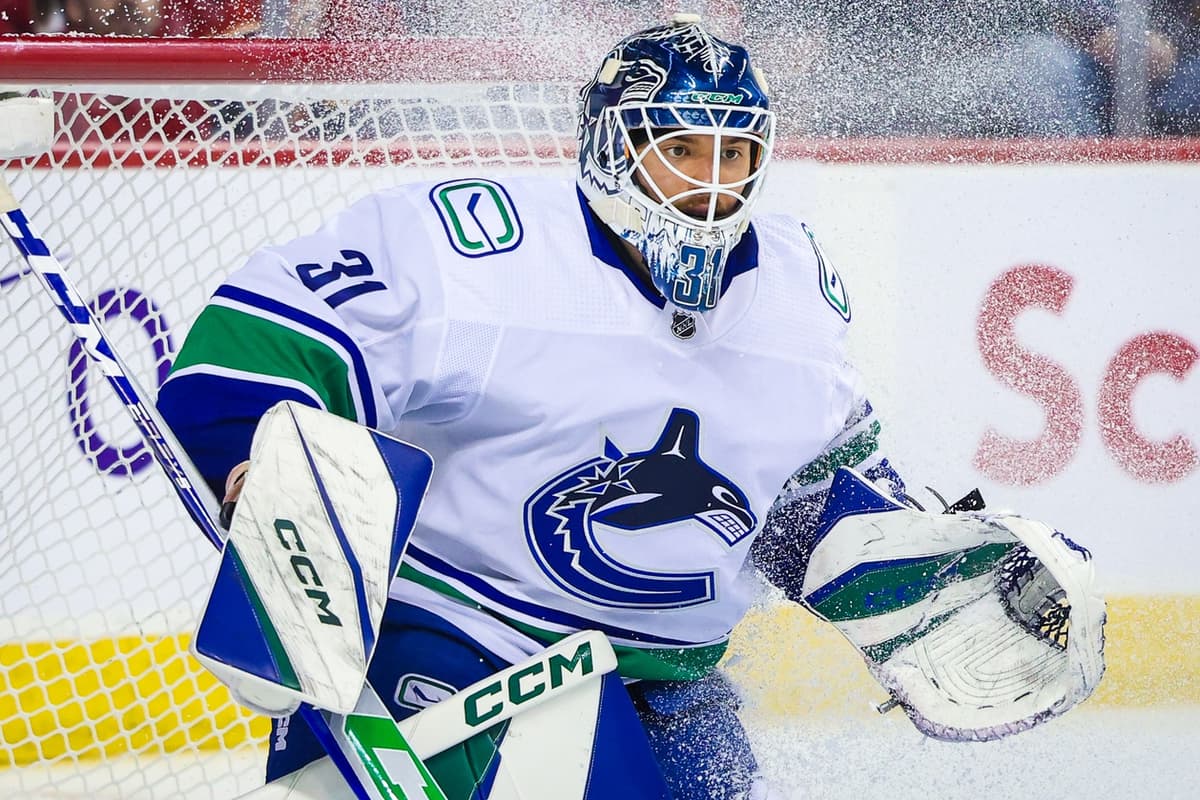
PHOTO CREDIT: © BOB FRID-USA TODAY SPORTS
We have both officially and unofficially entered a new era of Vancouver Canucks hockey.
Officially, whether you mark it by the arrival of President of Hockey Operations (POHO) Jim Rutherford, General Manager (GM) Patrik Allvin, or head coach Rick Tocchet, it’s clear that these Canucks have been an entirely different enterprise both on and off the ice.
Unofficially, we’ve now switched — and in shockingly quick succession — from questions of “How can they fix the seemingly unfixable holes on this roster?” to “What moves do they need to make in order to put this roster over the top?”
It was the worst of times, and now it’s getting pretty close to the best of times. But there are still many challenges ahead — they’re just different challenges.
As Allvin and Co. consider what trades and transactions the Canucks might need to take their playoff journey a couple of rounds deeper than last year, they find themselves faced with what might just be the new biggest challenge: a distinct lack of tradeable assets.
Let’s start by stating that this is not necessarily a bad problem to have. No obvious tradeable assets means, first and foremost, that there’s no one the Canucks are especially eager to remove from the depth chart.
That was not the case last year, as sophomore Andrei Kuzmenko proved to be an awkward fit and then was a convenient salary/value dump to Calgary in the Elias Lindholm deal.
Nor was it the case earlier in this offseason, as most rightly estimated that Ilya Mikheyev had to go based on the discrepancy between his salary and performance. The Canucks paid for the privilege of moving on from him and, in doing so, opened up the space they needed to land a high-profile free agent like Jake DeBrusk.
But that was the end of that. The new regime has not signed any new albatross contracts. They haven’t traded for anyone who hasn’t worked out. They have not — at least as far as we know publicly — brought any malcontents into the changeroom.

We, and you, and the Canucks’ front office alike can each probably look at the active roster and not see a single individual we’d like to be rid of.
That’s a good thing. But it does make figuring out team improvement a little more difficult because you typically need to ‘give’ in order to ‘get.’
In fact, it’s tough to look at the active roster and see anyone who might fit in a trade. You’ve got your core pieces, like Quinn Hughes, Elias Pettersson, JT Miller, Brock Boeser, Thatcher Demko, and probably DeBrusk and Filip Hronek now, too. They’ve all got major trade value but only open up a gap that immediately needs filling if they are traded.
You’ve got players that hold more value to the Canucks than they do to other teams. Like the trio of Dakota Joshua, Conor Garland, or Teddy Blueger. Could the Canucks trade any of the three? Absolutely. Should they? Not if they want to keep what they have going.
There are also those players who were just signed or extended and are thus extremely unlikely to be traded anytime soon, like Joshua and Blueger, but also Tyler Myers, Kiefer Sherwood, Derek Forbort, and Vincent Desharnais.
Also, Arturs Silovs isn’t going anywhere, barring an offer sheet, and probably not even then.
It doesn’t leave much for consideration.
Could someone like Carson Soucy have value on the trade market? Yes, most certainly. Are the Canucks going to replace his value in the lineup and improve on what they’ve got through trading him? That seems unlikely with Soucy on the books for just $3.25 million and already slotted into the top four.
The same could be said for Pius Suter. After last season, he’d no doubt have plenty of interest around the NHL. But then the Canucks would be losing all that multifaceted value he brings at $1.6 million. Who else would the club find that can play all four forward lines and all three forward positions at that price?

There are players around the fringes of the roster, like Noah Juulsen, Phil di Giuseppe, and Nils Åman. However, that wouldn’t move the needle on any trade of any significance.
Really, there are only two players on the active roster worth talking about on this front.
Nils Höglander put up 24 goals last season in what was almost a rookie season 2.0 more than a true sophomore campaign. With another year on his contract at a crisp $1.1 million, Höglander holds real value. But do the Canucks want to exploit that value right now? They need cheap contributions as badly as anyone else next year. And would they really want to move Höglander before seeing with more certainty if his offence is ‘the real deal’ or not? It’s probably a higher-risk move than they are hoping to make, but it will remain a possibility.
The other name worth considering is Vasily Podkolzin. The former 10th overall selection may look like a bust to some, but he’s put together a pro profile that should at least maintain a long bottom-six career for him. Podkolzin is similar to Höglander in that the Canucks need his cheap contributions next year and also in that they’d perhaps be hesitant to move him without fully knowing what he is. Podkolzin was drafted in the same year as Höglander, but his development has always been about a year behind. It’s probably worth more to hold on to Podkolzin for at least one more year to see if there is more of a breakout coming, especially considering his current limited trade value.
That said, between Podkolzin and Höglander, we are looking at the two most tradeable assets on the active roster. Like we said, it’s a challenge.
We can use Podkolzin to springboard the discussion into the other side of tradeable value: future-based assets. Unfortunately, despite some hardy efforts by the front office, the Canucks are still incredibly short on such pieces.
Draft pick-wise, the Canucks have their next three first-rounders and their next two second-rounders, and they don’t have a third until 2027.
Those three first-round picks immediately became Vancouver’s top tradeable assets. But then there’s some reason for caution here, too. The Canucks have made just two first-round selections since 2019 in Jonathan Lekkerimäki and Tom Willander. Their pick last year went to Calgary in the Lindholm deal.
They also haven’t made a second-round selection since taking Danila Klimovich in 2021.
Picks are always tradeable. But part of becoming competitive is staying competitive, and being able to consistently bring new young players on ELCs into the mix. Trade too many draft picks, and you run into the problem of not having enough quality prospects, which is the last thing we’re here to talk about today.
The Canucks do have some very high-quality prospects. The aforementioned Lekkerimäki and Willander are blue-chippers, make no mistake about it. But they’re not exactly moveable assets. Lekkerimäki is perhaps the only prospect in the entire organization with genuine top-six potential. They will need that from him sooner rather than later.
Willander, on the other hand, is one of the top RHD prospects in the world, and that’s a position for which there is always an enormous need. Pieces like him are hoarded, not traded.
Beyond him, the Canucks have both quality and quantity – as our own Dave Hall is currently highlighting in his top-20 prospects list – but not enough of either to be comfortable dealing many, if any, prospects.
Hunter Brzustewicz popped off for a surprising developmental year, became a redundant asset, and was flipped for Lindholm. The Canucks need someone else in the system to do the same, otherwise they will remain short on tradeables.
Could the likes of Elias Pettersson II and Aatu Raty have value around the league? Yep! Raty was already part of a trade for a big-ticket forward in Bo Horvat.
But such prospects are probably not needle-movers in any major trade. And they’re few enough in number that the Canucks would be best off hanging onto them, anyway.
And there you have it, and there the Canucks don’t.
There is a need to improve the team further. There is also a clear-cut dearth of tradeable assets with which to affect said improvement.
But challenges are only challenges until they are navigated, and Allvin and Co. have proven especially adept at paddling the rapids of NHL transaction-making thus far.
One has to assume it’s all part of the plan.





